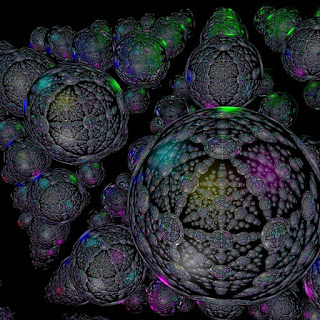Book Extract: Hua-Yen Buddhism: The Jewel Net of Indra by Francis H. Cook
At the heart of Huayen teachings is the image of Indra's Jewelled Net which fills the universe. Each part reflects equally the whole and the whole is reflected equally in each part. This is a very different view to the anthropocentric view.

A 3D rendering of Indra's net
Man often resembles Warty Bliggens, the toad in Don Marquis’ poem:
i met a toad
the other day by the name
of warty bliggens
he was sitting under
a toadstool
feeling contented
he explained that when the cosmos
was created
that toadstool was especially
planned for his personal
shelter from the sun and rain
through out and prepared
for him
do not tell me
said warty bliggens
that there is not a purpose
in the universe
the thought is blasphemy
a little more
conversation revealed that warty bliggens
considers himself to be
the center of the said
universe
the earth exists
to grow toadstools for him
to sit under
the sun to give him light
by day and the moon
and wheeling constellations
to make beautiful
the night for the sake of
warty bliggens.
Historically there has been little doubt on the part of Western man that he does stand apart from, and superior to, all else. When he gazes out at the creation, he sees a reality which is primarily broken and fragmented, with none of the continuity and interrelatedness which we observed in the Chinese landscape, and of course this discontinuity, or alienation, exists mainly for him and his confrontation with the other. This would be of merely academic interest where it not for the fact that such a view is said to cause the individual to suffer greatly.
Now, while there seems to be a fundamental difference in the way Western and Eastern people regard experience, let it not be assumed that a Chinese or Japanese is born into the world with a vision of identity and interdependence.
Buddhism was founded by an Indian and the Hua-yen school was a product of Chinese experience; both were taught to help Oriental people, who suffer from the same existential plight that Western people do. Human beings are basically the same in the manner in which they organize experience through recurrent training, learning to make sense out of what William James spoke of as a “blooming, buzzing confusion.” However, Buddhism did arise in the East, indicating that there is a tendency to see things as described by Hua-yen. Conversely, the tendency in the West has been to analyze rather than unify, to discriminate rather than see all as one, to make distinctions rather than see all qualities within each datum of experience. But the truth of the matter is that the universe as described in Hua-yen documents is the world as seen by enlightened individuals, Buddhas, and not by ordinary folk of any race, time or geographic area. Thus the Hua-yen vision is not at all self-evident even to a Chinese philosopher. The message of Buddhism is claimed to be universal; since all men suffer in the same basic way, the cure is universally beneficial.
(Hua-Yen Buddhism: The Jewel Net of Indra by Francis H. Cook; Penn State University Press 1977)
………………………………………………..
All Rights Reserved




